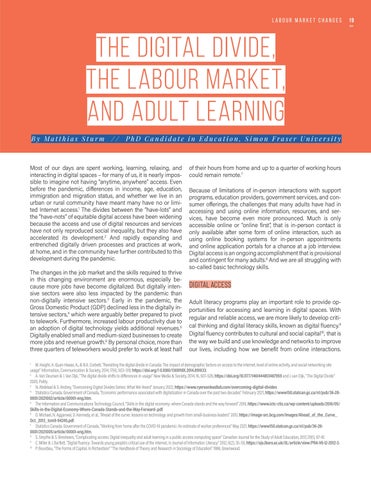Labour market changes
THE DIGITAL DIVIDE, THE LABOUR MARKET, AND ADULT LEARNING By Matthias Sturm
//
PhD Candidate in Education, Simon Fraser University
Most of our days are spent working, learning, relaxing, and interacting in digital spaces – for many of us, it is nearly impossible to imagine not having “anytime, anywhere” access. Even before the pandemic, differences in income, age, education, immigration and migration status, and whether we live in an urban or rural community have meant many have no or limi ted Internet access.1 The divides between the “have-lots” and the “have-nots” of equitable digital access have been widening because the access and use of digital resources and services have not only reproduced social inequality, but they also have accelerated its development. 2 And rapidly expanding and entrenched digitally driven processes and practices at work, at home, and in the community have further contributed to this development during the pandemic. The changes in the job market and the skills required to thrive in this changing environment are enormous, especially because more jobs have become digitalized. But digitally intensive sectors were also less impacted by the pandemic than non-digitally intensive sectors.3 Early in the pandemic, the Gross Domestic Product (GDP) declined less in the digitally intensive sectors,4 which were arguably better prepared to pivot to telework. Furthermore, increased labour productivity due to an adoption of digital technology yields additional revenues.5 Digitally enabled small and medium-sized businesses to create more jobs and revenue growth.6 By personal choice, more than three quarters of teleworkers would prefer to work at least half
of their hours from home and up to a quarter of working hours could remain remote. 7 Because of limitations of in-person interactions with support programs, education providers, government services, and consumer offerings, the challenges that many adults have had in accessing and using online information, resources, and services, have become even more pronounced. Much is only accessible online or “online first”, that is in-person contact is only available after some form of online interaction, such as using online booking systems for in-person appointments and online application portals for a chance at a job interview. Digital access is an ongoing accomplishment that is provisional and contingent for many adults.8 And we are all struggling with so-called basic technology skills.
DIGITAL ACCESS Adult literacy programs play an important role to provide opportunities for accessing and learning in digital spaces. With regular and reliable access, we are more likely to develop critical thinking and digital literacy skills, known as digital fluency.9 Digital fluency contributes to cultural and social capital10, that is the way we build and use knowledge and networks to improve our lives, including how we benefit from online interactions.
M. Haight, A. Quan-Haase, A., & B.A. Corbett, “Revisiting the digital divide in Canada: The impact of demographic factors on access to the internet, level of online activity, and social networking site usage” Information, Communication & Society, 2014, 17(4), 503–519, https://doi.org/1 0.1080/1369118X.2014.891633. 2 A. Van Deursen & J. Van Dijk, “The digital divide shifts to differences in usage” New Media & Society, 2014, 16, 507–526, https://doi.org/10.1177/1461444813487959 and J. van Dijk, “The Digital Divide” 2020, Polity. 3 N. Abdelaal & S. Andrey, “Overcoming Digital Divides Series: What We Heard” January 2022, https://www.ryersonleadlab.com/overcoming-digital-divides. 4 Statistics Canada. Government of Canada, “Economic performance associated with digitalization in Canada over the past two decades” February 2021, https://www150.statcan.gc.ca/n1/pub/36-280001/2021002/article/00001-eng.htm. 5 The Information and Communications Technology Council, “Skills in the digital economy: where Canada stands and the way forward” 2016, https://www.ictc-ctic.ca/wp-content/uploads/2016/05/ Skills-in-the-Digital-Economy-Where-Canada-Stands-and-the-Way-Forward-.pdf. 6 D. Michael, N. Aggarwal, D. Kennedy, et al., “Ahead of the curve: lessons on technology and growth from small-business leaders” 2013, https://image-src.bcg.com/Images/Ahead_of_the_Curve_ Oct_2013_tcm9-94245.pdf. 7 Statistics Canada. Government of Canada, “Working from home after the COVID-19 pandemic: An estimate of worker preferences” May 2021, https://www150.statcan.gc.ca/n1/pub/36-280001/2021005/article/00001-eng.htm. 8 S. Smythe & S. Breshears, “Complicating access: Digital inequality and adult learning in a public access computing space” Canadian Journal for the Study of Adult Education, 2017, 29(1), 67–81. 9 C. Miller & J. Bartlett, “Digital fluency: Towards young people’s critical use of the internet, in Journal of Information Literacy” 2012, 6(2), 35–55, https://ojs.lboro.ac.uk/JIL/article/view/PRA-V6-I2-2012-3. 10 P. Bourdieu, “The Forms of Capital. In Richardson” “The Handbook of Theory and Research in Sociology of Education” 1986, Greenwood. 1
19





